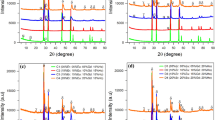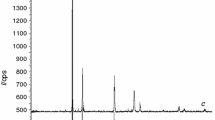Abstract
Electrical conductivity, fluorite-type cubic unit cell volume and thermal expansion of the (Bi1− x Nb x )1− y Ho y O1.5+δ (x=0.05 and 0.08; y=0.10−0.15) and (Bi1− x Zr x )1− y Y y O1.5+δ (x=0.05 and 0.07; y=0.15) solid solutions have been found to decrease regularly with increasing dopant content. Annealing at temperatures below 900 K leads to a phase decomposition and to a sharp decrease in conductivity of the ceramics. Oxygen ion transference numbers have been determined by the e.m.f. method and by Faradaic efficiency measurement to exceed 0.9. A new technique of studying Faradaic efficiency has been proposed and verified using (Bi0.95Zr0.05)0.85Y0.15O1.5+δ and Zr0.90Y0.10O1.95 ceramic samples.
Similar content being viewed by others
Author information
Authors and Affiliations
Additional information
Received: 31 October 1997 / Accepted: 18 December 1997
Rights and permissions
About this article
Cite this article
Yaremchenko, A., Kharton, V., Naumovich, E. et al. Oxygen ionic transport in Bi2O3-based oxides: II. The Bi2O3–ZrO2–Y2O3 and Bi2O3–Nb2O5–Ho2O3 solid solutions. J Solid State Electrochem 2, 308–314 (1998). https://doi.org/10.1007/s100080050105
Issue Date:
DOI: https://doi.org/10.1007/s100080050105




